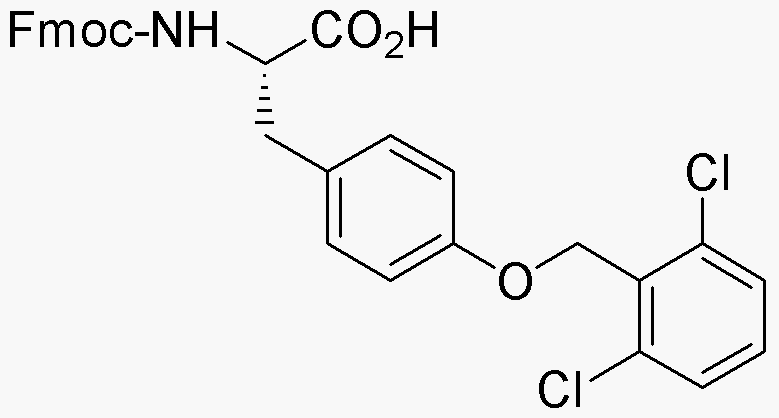Fmoc-O-2,6-dichlorobenzyl-L-tyrosine is widely utilized in research focused on:
- Peptide Synthesis: This compound is a key building block in the synthesis of peptides, especially in solid-phase peptide synthesis (SPPS), allowing for the creation of complex peptide sequences with high purity.
- Drug Development: It plays a significant role in the pharmaceutical industry, particularly in the design of peptide-based drugs, which can lead to more effective treatments with fewer side effects.
- Bioconjugation: The compound is used in bioconjugation processes, enabling the attachment of biomolecules to drugs or imaging agents, enhancing their targeting capabilities and efficacy.
- Research in Neuroscience: It is utilized in studies related to neurotransmitter pathways, contributing to the understanding of neurological disorders and the development of potential therapies.
- Protein Engineering: Fmoc-O-2,6-dichlorobenzyl-L-tyrosine is valuable in protein engineering, allowing researchers to modify proteins for improved stability and functionality in various applications.
General Information
Properties
Safety and Regulations
Applications
Fmoc-O-2,6-dichlorobenzyl-L-tyrosine is widely utilized in research focused on:
- Peptide Synthesis: This compound is a key building block in the synthesis of peptides, especially in solid-phase peptide synthesis (SPPS), allowing for the creation of complex peptide sequences with high purity.
- Drug Development: It plays a significant role in the pharmaceutical industry, particularly in the design of peptide-based drugs, which can lead to more effective treatments with fewer side effects.
- Bioconjugation: The compound is used in bioconjugation processes, enabling the attachment of biomolecules to drugs or imaging agents, enhancing their targeting capabilities and efficacy.
- Research in Neuroscience: It is utilized in studies related to neurotransmitter pathways, contributing to the understanding of neurological disorders and the development of potential therapies.
- Protein Engineering: Fmoc-O-2,6-dichlorobenzyl-L-tyrosine is valuable in protein engineering, allowing researchers to modify proteins for improved stability and functionality in various applications.
Documents
Safety Data Sheets (SDS)
The SDS provides comprehensive safety information on handling, storage, and disposal of the product.
Product Specification (PS)
The PS provides a comprehensive breakdown of the product’s properties, including chemical composition, physical state, purity, and storage requirements. It also details acceptable quality ranges and the product's intended applications.
Certificates of Analysis (COA)
Search for Certificates of Analysis (COA) by entering the products Lot Number. Lot and Batch Numbers can be found on a product’s label following the words ‘Lot’ or ‘Batch’.
Numéro de catalogue
Numéro de lot/série
Certificates Of Origin (COO)
This COO confirms the country where the product was manufactured, and also details the materials and components used in it and whether it is derived from natural, synthetic, or other specific sources. This certificate may be required for customs, trade, and regulatory compliance.
Numéro de catalogue
Numéro de lot/série
Safety Data Sheets (SDS)
The SDS provides comprehensive safety information on handling, storage, and disposal of the product.
DownloadProduct Specification (PS)
The PS provides a comprehensive breakdown of the product’s properties, including chemical composition, physical state, purity, and storage requirements. It also details acceptable quality ranges and the product's intended applications.
DownloadCertificates of Analysis (COA)
Search for Certificates of Analysis (COA) by entering the products Lot Number. Lot and Batch Numbers can be found on a product’s label following the words ‘Lot’ or ‘Batch’.
Numéro de catalogue
Numéro de lot/série
Certificates Of Origin (COO)
This COO confirms the country where the product was manufactured, and also details the materials and components used in it and whether it is derived from natural, synthetic, or other specific sources. This certificate may be required for customs, trade, and regulatory compliance.


